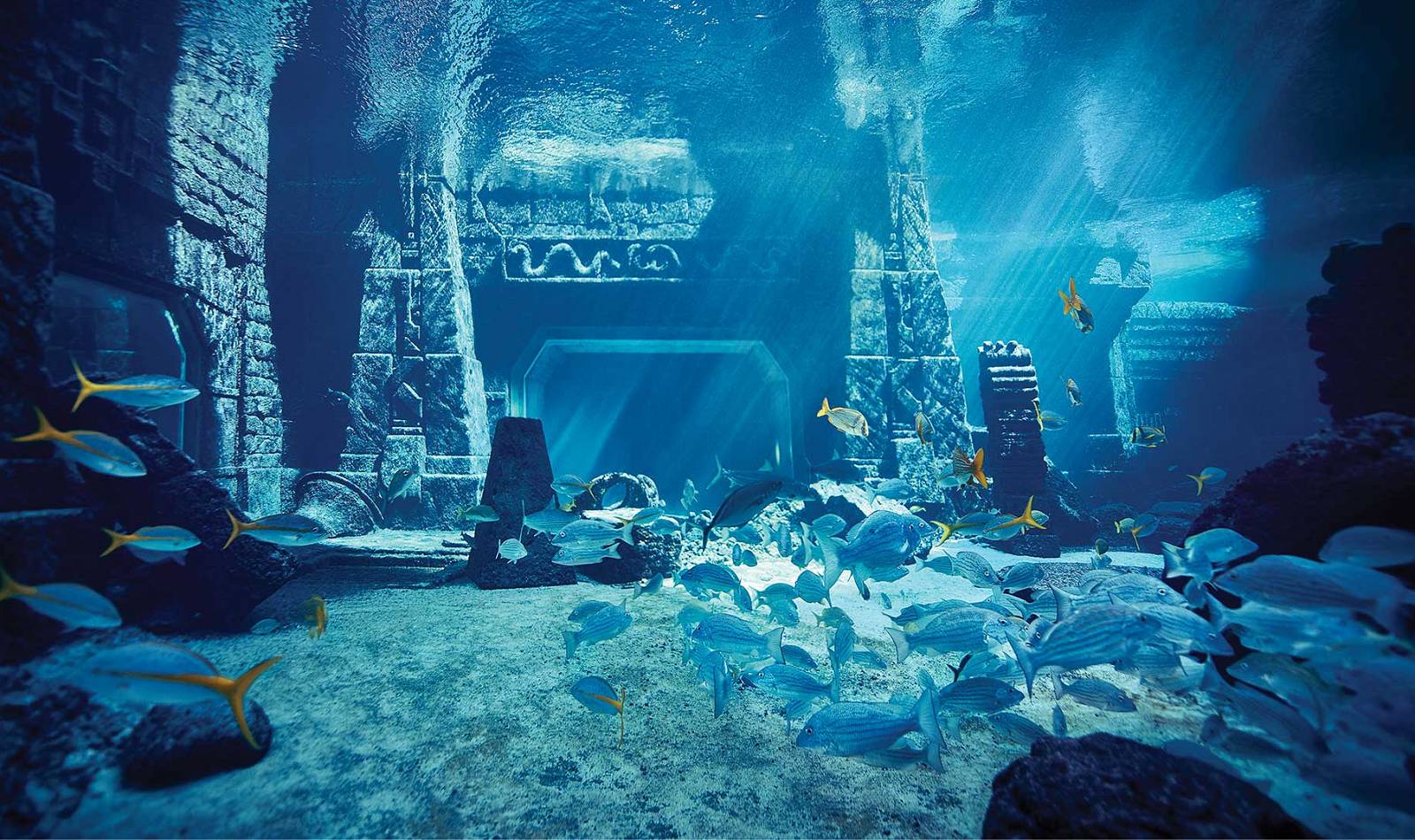

Welcome to the Dig
As you descend the steps below The Royal Lobby and approach the entrance to The Dig, behold the remarkable underwater view of The Ruins, an enormous aquarium depicting the sunken City of Atlantis.
According to the myth, a catastrophic volcanic eruption caused an earthquake and a great flood that completely submerged the city.
Built by Olio from Venice, California, The Dig is regarded as the world's largest recreation of the mythical Atlantis.
Based on Plato's writings, The Dig and it's 15 chambers are meant to imitate a 600-foot-long archeological dig in search of signs of the lost ancient city. Explore The Dig by entering from the lower level of The Royal Lobby.


The first chamber of The Dig is the South Anteroom, the base camp of archaeologists established from over a century ago. They have found a way to access Atlantis and removed the Stone Seal that leads to the legendary city.

Once used by the Atlanteans for waste disposal, this site has now been taken over by spiny lobster (Panulirus argus) and slipper lobster (Scyllarides aequinoctialis). These reef dwellers grow by molting. This occurs when the shell, or exoskeleton, splits apart, exposing the new shell that has developed under it. When Atlantis sank into the sea, these spiny lobsters found a nice home for themselves.

Once the end of a main street, this area is now home to venomous red lionfish (Pterois volitans,) yellow tang (Zebrasoma flavescens), palette surgeonfish (Percanthurus hepatus), powderblue surgeons (Acanthurus leucosternon), foxface rabbitfish (Siganus vulpinus), blue line rabbitfish (Siganus doliatus) and long-spined urchin (Diadema antillarum.) Native to the Indian and Pacific Oceans, lionfish have become an invasive species in The Bahamas, outcompeting native species of fish.

As you wander down the Boulevard Terminus, you'll encounter the Jewel Statuary next to the Lionfish Exhibit. You'll easily recognize it because of the figure eight stone sculpture that symbolizes infinity. African cichlids protect this precious stone sculpture. Atlanteans placed written wishes in the holes within the walls behind this ancient icon. Go ahead and make your wishes here, too.
After thousands of years, this beautiful fountain's pumping mechanism still functions, but now it is used to oxygenate the water for Palometa Jacks (Trachinotus goodei), silver fish with black bars and elongated dorsal & pectoral fins).


The goliath grouper (Epinephelus itajara) and the Nassau grouper (Epinephelus striatus) now make their home in what was once part of the lab. The goliath grouper can grow more than 8 feet in length and weigh more than 800 lbs. Groupers gather annually in huge numbers to spawn on ancestral grounds.

Directly across from the Goliath groupers, you'll notice some very interesting vestiges of a research laboratory. Atlanteans were extraordinary scientists as evidenced by the wealth of innovative apparatus in this room. The georesonant clock and other devices were used to record sensitive measurements and to calculate and interpret data.

Marvel at the crystal machining room. Hanging from the ceiling is a humongous saw that Atlanteans used to cut their precious crystals. The different tools for precision cutting with this saw are stored on the wall to the right of the worktable.
MORAY EEL EXHIBIT
This storage room for Atlantean pots and urns has become the perfect home for green moray eels (Gymnothorax funebris.) Eels are actually fish.
The green color of these animals is produced by a yellow mucous layer, which overlays the darker blue skin. They grow to an impressive length of 6 feet.


These rooms are believed to be storage chambers used to store light-sensitive navigational documents. It is the perfect setting to view moon jellyfish (Aurelia aurita.) These animals are 98% water and do not have a brain, central nervous system or eyes.

One of several aquariums that is home to a variety of reef fish and coral species. The small animals that make up a coral colony are called polyps and are filter feeders.
Coral reefs are threatened due to pollution, climate change and overfishing.

Look for the bright orange and white clownfish (Amphiprion ocellaris,) one of the most recognizable reef-dwellers. They only reach about 4 inches in length and are named for the multicolored sea anemone (Condylactis gigantea) in which they make their homes. In this symbiotic relationship, the clownfish thrive among the anemone, despite its venomous tendrils. Clownfish have developed a unique biological immunity to the toxin.

The structure in the middle of the chamber is called The Abyss…the gateway that gave the Atlanteans access to the pits of the ocean. Directly above hangs the diving bell, used as an underwater study center. It is lowered from the ceiling, into the portal and down the ocean depths.

This is perhaps the chamber offering the most dramatic and climactic view. This stunning panorama, with the grand stone steps leading up to the surface, is a depiction of what the lost ancient city might look like if it rose again from beneath the ocean.

When planning their journeys, Atlanteans would utilize city models such as the one found in this room that projected information about the weather, accessible routes and planetary positions. To view this information, they donned helmets fitted with specialized lenses that corresponded to either land, sea or air travel.
Your dream Bahamas vacation is closer than you think. Book your last-minute getaway, save up to 30% and unwrap paradise this season.
Your dream Bahamas vacation is closer than you think. Book your last-minute getaway, save up to 30% and unwrap paradise this season.
Make 2026 the year you say yes to adventure, relaxation, and to the unforgettable at Atlantis Bahamas. Book today and unlock; up to 35% off, complimentary daily breakfast for two.*
Make 2026 the year you say yes to adventure, relaxation, and to the unforgettable at Atlantis Bahamas. Book today and unlock; up to 35% off, complimentary daily breakfast for two.*